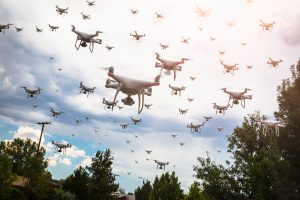
Autonomous drone aircraft traffic in uncontrolled airspace below 400 feet altitude is expected to substantially increase in the next few years. Experts anticipate a fleet of nearly 1 million commercial uncrewed aircraft systems (UAS) in the U.S. by 2027, engaging in tasks like package delivery, traffic monitoring, and emergency assistance.
A team of researchers led by Lanier Watkins, chair of the EP Computer Science and EP Cybersecurity programs, and Louis Whitcomb, co-chair of the EP Robotics and Autonomous Systems program, has used artificial intelligence to model a system that could more safely orchestrate drone traffic by replacing some human-in-the-loop processes with autonomous decision-making. Their results appeared in IEEE’s Computer: “The Roles of Autonomy and Assurance in the Future of Uncrewed Aircraft Systems in Low-Altitude Airspace Operations”
“We wanted to see if different approaches using AI could handle the expected scale of these operations in a safe manner, and it did,” said Watkins, an associate research professor in the Whiting School of Engineering’s Department of Computer Science, a researcher at the Institute for Assured Autonomy, and principal professional staff at the Johns Hopkins Applied Physics Laboratory. “Our simulated system leverages autonomy algorithms to enhance the safety and scalability of UAS operations below 400 feet altitude.”
To address the challenge of increasing UAS traffic, the Hopkins team evaluated the impact of autonomous algorithms in a simulated 3D airspace. The team knew from their previous research that using collision avoidance algorithms greatly reduced accidents. Adding strategic deconfliction algorithms, which control traffic timing to avoid collisions, made things even safer and nearly eliminated airspace accidents, they found.
The researchers also equipped their simulator with two aspects of realism. “Noisy sensors” mimic the unpredictability of real-world conditions and make the system more adaptable, and a “fuzzy interference system” calculates the risk level for each drone based on factors ranging from proximity to obstacles to adherence to the planned route. Watkins and Whitcomb say that these approaches allow the system to make autonomous decisions to prevent collisions.
“Our study considered a variety of variables, including scenarios that involve ‘rogue drones’ that deviated from their planned routes. The results are very promising,” said Whitcomb, who in addition to his EP role, is a professor of mechanical engineering at the Whiting School of Engineering and a researcher at the Institute for Assured Autonomy.
The team plans to enhance its simulations further by including dynamic obstacles like weather and other real-world factors for a more comprehensive representation.
Watkins says that the paper builds on more than two decades of research conducted at the Johns Hopkins University Applied Physics Laboratory focused on enhancing the safety of the U.S.’s National Airspace System.
“This work has been investigated through simulating performance in environments and systems that are being considered for deployment by third parties in future airspaces, as well as in the academic and basic research IEEE and ACM communities,” explains Watkins. “This work helps researchers understand how autonomy algorithms that protect airspace can behave when faced with noise and uncertainty in 3D-simulated airspace and underscores the need to continuously monitor the results from these autonomous algorithms to ensure they have not reached potential failure states.”
Along with his roles in Engineering for Professionals, Watkins is principal staff and a section supervisor in the Critical Infrastructure Protection Group within the Asymmetric Operations Sector of the Johns Hopkins University Applied Physics Laboratory. He also holds a secondary appointment as an associate research professor with the JHU Information Security Institute.